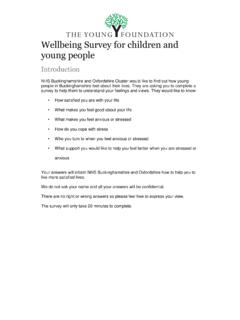Transcription of ACTIVE NZ - Sport New Zealand
1 ACTIVE NZ. MAIN REPORT.. The New Zealand Participation Survey 2018. ACKNOWLEDGEMENTS. Sport New Zealand 's ACTIVE NZ survey measures nationwide participation in play, ACTIVE recreation and Sport . Following the redesigned ACTIVE NZ survey in 2017, this second year of data collection is the beginning of a new time series on participation in play, ACTIVE recreation and Sport for New Zealanders aged 5 -plus. This report updates the main participation statistics and focuses on hurdles to further participation. The ACTIVE NZ Spotlight on the Impact of Socioeconomic Deprivation complements this report. Special thanks go to all those who have provided feedback to guide the development of this report and the thousands of New Zealanders who took part in the ACTIVE NZ survey.
2 AUTHORS. The main author of this report is Janette Brocklesby, working alongside others at Sport Ne w Zealand and Nielsen. CITATION. Sport New Zealand , 2019. ACTIVE NZ 2018 Participation Report. Wellington: Sport New Zealand Download this report at WANT TO FIND OUT MORE? ACTIVE NZ resources are available at Contact: CONTENTS. GLOSSARY PAGE 4. ABOUT THIS REPORT PAGE 5. KEY RESULTS PAGE 6. PARTICIPATION. 01 HOW MANY, WHO, AND HOW MUCH HAPPENS IN ANY. GIVEN WEEK? PAGE 9. WHY TIME SPENT PARTICIPATING. 02 MATTERS. WHY IS THE AMOUNT OF TIME SPENT PARTICIPATING. PAGE 12. IMPORTANT? 03 HOW people PARTICIPATE. HOW DO people PARTICIPATE? PAGE 15. young people . 04 HOW DO young people ALLOCATE TIME.
3 SPENT IN ORGANISED AND INFORMAL. PAGE 17. PARTICIPATION? 05 MOTIVATION. WHAT MOTIVATES people TO PARTICIPATE? PAGE 20. 06 HURDLES. WHAT GETS IN THE WAY OF people PARTICIPATING? PAGE 23. APPENDICES A D PAGES 31 44. (August 2019) 3. GLOSSARY. Respondents people who took part in the survey. Adult Respondents aged 18-plus. young people Respondents aged from 5 to 17. people who have been physically ACTIVE in play, exercise, ACTIVE recreation or Sport in the past seven days, where this participation excludes any physical activity undertaken for work or chores. Participants Participation can include physical activity undertaken to get from one place to another ( ACTIVE transport) if the respondent considers it to be for Sport or ACTIVE recreation.
4 people who have not been physically ACTIVE in play, exercise, ACTIVE recreation or Sport in the Non-participants past seven days. Participation in Participating through an organised structure, for example, in a league or club competition, competitive and tournament or competitive event. Non-competitive participation refers to sports or activities non-competitive sports undertaken outside of a league or club competition, tournament or competitive event. or activities Applies to young people only. Participation in a competition or tournament is one component of organised participation. Other organised sports and activities include being physically ACTIVE in Organised participation physical education or class at school, Sport and activities undertaken in a competition and training, or practising with a coach or instructor.
5 Applies to young people only. Informal sports and activities include being physically ACTIVE Informal participation through play with others, playing alone, extra training activities , or practising without a coach or instructor. Play, ACTIVE recreation and Sport are used throughout this report for simplicity. However, participation is multi-faceted. Play and ACTIVE recreation are terms used by Sport New Zealand to capture participation in activities not considered to be Sport , for example, playing with friends or Play, ACTIVE recreation, alone, dance and tramping. Sport can be undertaken in an organised structure, for example, in a and Sport competition or tournament, or informally outside an organised structure.
6 Sport is associated with being competitive, but individuals differ in their degree of competitiveness, irrespective of how they participate. Refers to being physically ACTIVE in play, exercise, ACTIVE recreation or Sport at least once in the Weekly participation past seven days. Results by ethnicity throughout this report European, M ori, Pacific (including Samoan) and Ethnicity Asian (including Indian and Chinese) are based on respondents' self-identification. (August 2019) 4. This report provides an update on the main participation indicators ACTIVE NZ in play, ACTIVE recreation and Sport in 2018 by New Zealanders aged 5-plus. Changes year on year between 2017 and 2018 have been noted.
7 ABOUT THIS REPORT This report primarily uses data collected through the ACTIVE NZ survey between 5 January 2018 and 4 January 2019 from 5595 young people (aged 5 17) and 25 150 adults (aged 18-plus).1. It focuses on: how much participation happens in any given week , how many people are participating, and who they are how people participate how young people allocate their time spent in organised and informal participation what motivates participation what the barriers are to participation. To provide more robust analysis of population sub-groups, results are presented using data collected through the ACTIVE NZ survey over two years (between 5 January 2017 and 4 January 2019) from 11 599.
8 young people (aged 5 17) and 52 188 adults aged 18-plus) in two instances: 1. identifying motivations for participating in the top 12 sports and activities (pages 21 and 22). 2. taking a closer look at hurdles (section 6, pages 23 30). Differences (and similarities) are highlighted between young people and adult participation, as is variation by gender and ethnicity. The Spotlight on the Impact of Socioeconomic Deprivation complements this report. Note that results have been drawn from two separate surveys and data sets: one for young people aged between 5 and 17 and one for adults aged 18-plus. Commentary about differences between young people and adults is based on observations rather than statistical testing between the two data sets.
9 Within the two data sets, reported differences between the total result and sub-groups are statistically significant at the 95 percent confidence level. Significance testing means we can be sure the differences reported are not due to random variation because we are using a sample and not conducting a population census. Knowing a difference is statistically significant does not mean the difference is important, and only meaningful differences have been commented Data tables accompanying the report contain all base sizes and highlight all statistically significant differences at the 95 percent confidence level. Please note, in some cases, a significant difference is evident between two numbers that appear to be the same or no significant difference can be seen when it may appear there should be one.
10 This is due to rounding and variation in sample sizes. 1. For further information on method, sample and objectives, see appendix C and the Technical Report: Sport NZ. ACTIVE NZ Technical Report for Data Collected in 2018. Wellington: Sport NZ, 2018. 2. For more detail on the statistical testing, refer to the Technical Report (above note). (August 2019) 5. KEY RESULTS. Changes in participation: Comparing 2018 results with 2017. This is the beginning of a new time series on participation in play, ACTIVE recreation and Sport for New Zealanders aged 5-plus. Significant changes in participation indicators between 2017 and 2018 follow. 1. Adult weekly participation in play, ACTIVE recreation and Sport has dropped by 1 percent , from 73 percent to 72 percent, and changes have also occurred by gender: 2 percent drop for females, from 74 percent to 72 percent 2.










